Frequently during the life of a building constructed of concrete masonry units (CMU) or brick, it is no longer feasible to refurbish the exterior by pressure washing and applying more coats of paint (Photo 1 below).

This occurs because:
- The existing coating becomes too thick or too poorly adhered to support the weight and curing stresses of another coat, or
- The number of coats causes the permeability of the system to be too low to allow moisture vapor to pass through, or
- The desired repaint material is incompatible with the existing coating.
In these cases, some or all of the existing coating needs to be removed and replaced.
Removal of the coating from CMU and brick can prove challenging, and a number of decisions need to be made at the design stage in order to select the optimum paint-removal method for the job. Questions that need to be considered include:
- Does the existing coating have to be completely removed or just the loose coating? Cost and complexity increase significantly if all of the coating must be removed.
- Can heavy roughening of the block or brick face be tolerated, including some damage to mortar joints? Note that for historic preservation, even very slight roughening may be unacceptable.
- Can existing paint be allowed to remain present within the porosity of the block?
- Can large volumes of water be tolerated (environmentally, and in terms of potential water intrusion into the block or brick)?
- Can airborne dust be tolerated?
The answers to these questions will help to identify candidate methods of surface preparation for the project. The questions are presented again at the conclusion of this article, together with candidate methods of cleaning based on the responses to each.
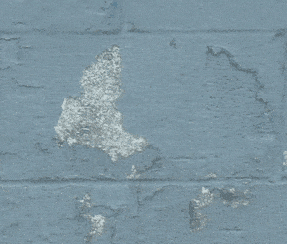
Industry standards
A few industry standards identify methods of surface preparation that can be used on CMU, brick, and other concrete surfaces (floors, poured walls, precast, etc.). Unfortunately, most of the standards focus on the preparation of floors or concrete substrates that are bare, rather than painted CMU or brick.
Also, the standards do not provide definitive acceptance criteria for judging the degree of cleaning that is carried out. Most of the standards essentially state that sufficient material must be removed to achieve a sound concrete surface free of laitance, glaze, efflorescence, and incompatible curing compound.
Accordingly, while the methods described may be suitable for use on CMU and brick, the language in the standards does not specifically provide acceptance criteria when removing existing paint from these substrates.
A few of the standards are described below, produced by SSPC (Society for Protective Coatings), NACE (National Association of Corrosion Engineers), ICRI (International Concrete Repair Institute), and ASTM International (formerly American Society for Testing and Materials)
SSPC-SP13/NACE No. 6, Surface Preparation of Concrete. This standard briefly describes methods that are available for cleaning a variety of concrete surfaces, and frequently references other ASTM and NACE standards. It addresses the following methods of surface preparation:
- Dry-abrasive blast cleaning, wet-abrasive blast cleaning, vacuum-assisted abrasive blast cleaning, and centrifugal shot blast cleaning with references to ASTM D4259 (described below). These methods will remove existing coating, but possess the potential to significantly roughen or damage the surface of the block or brick and mortar joints.
- High-pressure water cleaning or water jetting according to SSPC-SP12/NACE No. 5 or ASTM D4259 (described below). These methods will remove poorly adhered coating, allowing intact coating to remain, or completely remove existing coating given that adequate pressures and dwell times are used. They will be less damaging to the surface of the block and brick than the abrasive blast-cleaning methods, but some roughening will occur.Note that SSPC-SP12/NACE No. 5 is titled Surface Preparation and Cleaning of Metals by Water Jetting Prior to Recoating. While the methods described in the standard are suitable for use on concrete, the acceptance criteria for the degrees of cleaning are based on metallic substrates.
- Impact power tools according to ASTM D4259 (described below). These methods include needle gunning and rotary peening, which will remove existing coating but will fracture and remove concrete at the same time. These tools are not commonly used on CMU or brick because of the potential damage created.
- Power grinding, sanding and wire brushing according to ASTM D4259 (described below). While coatings can be completely removed by grinding or sanding, these methods are more commonly used for the removal of loose coating and for feathering edges.
- Acid etching according to ASTM D4260. Acid etching is used on horizontal surfaces to etch bare concrete; it will not remove existing coating.
- Flame (thermal) cleaning. This method is used to extract organic contaminates from concrete, but is not suggested for coating removal.
- Methods used for cleaning contaminants from the surface prior to painting are also addressed. The methods are vacuum cleaning, air-blast cleaning, water cleaning, detergent water cleaning, and steam cleaning, all according to ASTM D4258.
ICRI Guideline No. 310.2-1997 (formerly No. 03732), Selecting and Specifying Concrete Surface Preparation for Sealers, Coatings, and Polymer Overlays. This guideline addresses methods of surface preparation used on concrete. While the focus of the guideline is on concrete floors, some of the methods are suitable for use on CMU and brick. It also includes nine (9) concrete surface-profile (CSP) coupons that are replicas of the type of profile (surface roughness) created by the various methods of surface preparation (Photo 2).
The coupons range in texture from very smooth, typical of acid etching (CSP1), to very rough, typical of heavy scarification (CSP 9).

Methods addressed in the ICRI Guideline that are capable of removing coatings from CMU and brick are listed below. Note the similarity to the methods listed above in SSPC-SP13/NACE No. 6.
- Abrasive blasting (will remove coatings, but has the potential to significantly roughen or damage the surface of the block or brick as well as mortar joints).
- Scarifying (will remove coatings, but is extremely aggressive to the substrate)
- Needle scaling (will remove coatings, but is very aggressive to the substrate)
- High/ultra-high-pressure water jetting (can remove coatings and minimizes damage to the substrate, but some roughening will occur)
- Low-pressure water cleaning (will typically remove only loose coating)
Methods in the Guideline that will not totally remove coating or are not suitable for use on CMU and brick are:
- Detergent scrubbing (will not remove coating)
- Acid etching (will not remove coating—used on bare horizontal surfaces)
- Grinding (will remove coating, but equipment addressed in the Guide is limited to floors)
- Steel shotblasting (will remove coating, but equipment in the Guide is limited to floors)
- Scabbling (will remove coatings but is extremely aggressive to the substrate and best used on floors)
- Flame blasting (can remove coating, but is not recommended due to the hazards involved with burning the paint)
- Milling/rotomilling (will remove coating and top layer of concrete, but used on slabs and not suitable for CMU/brick)
ASTM D4258, Standard Practice for Surface Cleaning Concrete for Coating. This practice briefly describes methods of cleaning that will remove surface contaminants such as grease, dirt, and loose material, but will not remove coatings. These methods are used in conjunction with other coating-removal methods to assure that the surface is free of contamination prior to painting. The methods addressed are broom cleaning, vacuum cleaning, air-blast cleaning, water cleaning, detergent water cleaning, and steam cleaning.
ASTM D4259, Standard Practice for Abrading Concrete. This practice addresses methods for removing material, including coatings, and roughening the surface. The methods addressed are the following.
- Mechanical abrading; these methods involve power tools, both impact and grinding. The power tools are capable of removing coating, but are better suited for localized use. The impact tools can also cause damage to the substrate.
- Water blast cleaning; this method involves high-pressure water blasting, but the pressures are not defined. Given adequate pressure and dwell time, coatings can be removed.
- Abrasive blast cleaning; these methods include dry blasting, wet blasting, and use of a self-contained apparatus that reuses the abrasive. These methods will remove coating, but can significantly roughen the substrate in the process.
ASTM D4260, Standard Practice for Liquid and Gelled Acid Etching of Concrete. This practice addresses the preparation of bare concrete by acid etching, but will not remove existing coatings.
ASTM D4261, Standard Practice for Surface Cleaning Concrete Masonry Units for Coating. This practice addresses the same surface-cleaning methods covered in ASTM D4258, with the addition of mechanical tool cleaning for the removal of mortar spatter and efflorescence. The standard is not applictble to the removal of existing coatings.
Production rates
Production rates for some of the methods are provided in the Painting and Decorating Contractors of America (PDCA) Estimating Guide Volume 2, Rates and Tables. (www.PDCA.org), as well as ICRI Guideline No. 310.2-1997 described above (www.icri.org).
Coating-removal methods for CMU and brick
As is apparent from the review of the standards, only a few of the methods are suitable for wholesale removal of existing coating from CMU and brick, and even then, there are risks associated with damage to the substrate or the potential for excessive water intrusion. Also, an effective method of coating removal—chemical stripping—is not addressed in the above standards.
With any of the methods, it is advisable to do test areas before undertaking wholesale removal in order to perfect the removal process and to confirm the acceptability of any roughening of the substrate that may occur.
Brief summaries of methods that could be used on CMU and brick are provided below.
Dry abrasive blast cleaning
Compressed air is used to propel abrasive particles against the surface at high velocity. The impact of the abrasive fractures and dislodges the paint (Photo 3).
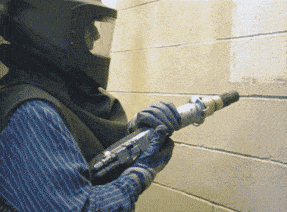
While abrasive blast cleaning can efficiently remove paint, when used on smooth and split-faced block, all traces of paint within the irregularities of the surface will not be removed without significant erosion of the block surface (Photo 4). Abrasive blast cleaning also has the potential to cause damage to mortar joints if lengthy dwell times are required to remove the paint.
Coatings such as elastomerics can also be difficult to remove by abrasive blast cleaning because the abrasive tends to bounce off of the coating, rather than cut into it. In these cases, the operator must attempt to “work” the coating off the surface by blasting beneath it at an angle, but if the adhesion is good, even this process may not be successful.
Blast-cleaning abrasives include a variety of slag byproducts (boiler slag, copper slag, nickel slag), garnet, crushed glass, sponge, walnut shells, and others.
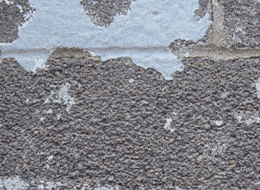
The operation is very dusty, caused by the breakdown of the paint, breakdown of the abrasive as it impacts the surface, and the erosion of the CMU or brick. If the dust cannot be tolerated due to ambient air regulations or the location of the building, ventilated containment systems that are maintained under negative pressure using dust-collection equipment can be used, but they are costly to install and maintain.
Guidance on containment systems can be found in SSPC Guide 6, Guide for Containing Surface Preparation Debris Generated During Paint Removal Operations.
Wet abrasive blast cleaning
Wet abrasive blast cleaning is a variation of dry abrasive blast cleaning described above with the same potential for damage to the substrate (Photos 4 and 5). The principles of operation and coating removal are the same except that water is introduced into the compressed air/abrasive stream to significantly reduce the generation of airborne dust. Water can be introduced using a special nozzle that mixes the water with the abrasive prior to exiting the nozzle, or through a water collar that is attached to the nozzle, which introduces water to the abrasive as it exits the nozzle.
Systems are also available that create a water/abrasive slurry that is pumped through the blast hose using compressed air.

Sodium bicarbonate blast cleaning
Sodium bicarbonate blast cleaning is similar to wet abrasive blast cleaning, except that the abrasive consists of baking soda, but with larger particle sizes than the baking soda found at home. The sodium-bicarbonate abrasive is propelled to the surface using compressed air. Water is typically added to the abrasive stream at the nozzle to control the dust. Without the water, the operation is extremely dusty.
The process can remove paint, but it is best used to clean the surface (remove chalking, graffiti, and contamination) prior to painting. It can also be used on bare brick for the removal of streaks of efflorescence prior to the application of seal coats. It is important to flush all residues of sodium bicarbonate from the surface before painting or sealing the surface.
Pressure washing (low-pressure water cleaning (<5,000 psi), and high-pressure water cleaning (5,000 to 10,000 psi))
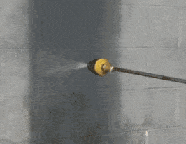
SSPC-SP12/NACE No. 5, Surface Preparation and Cleaning of Metals by Water Jetting Prior to Recoating, divides pressurized water systems into two broad categories: Water Cleaning (less than 10,000 psi) and Water Jetting (greater than 10,000 psi).
Despite the word “metals” in the title of the standard, water cleaning-and water-jetting equipment are used for the preparation of CMU and brick, although the definitions for the degrees of cleaning in the standard are written for metallic substrates. Water cleaning is discussed below; water jetting is discussed in the following section. The SSPC/NACE standard indicates that flow rates from 1 gal./min. to14 gal./min. are common for the water-removal methods.

Water Cleaning is divided into two categories: Low-Pressure Water Cleaning (less than 5,000 psi) and High-Pressure Water Cleaning (5,000 to 10,000 psi). Although the methods are labeled as “water cleaning,” they can effectively remove loose coating (Photo 6). Pressure-washing methods are also capable of removing intact coatings, especially at the higher pressures and when a zero-degree rotating tip is used.
When removing all coatings, the downside to these methods is that a large volume of water is introduced to the surface (generally 5 to 10 gals./min.) which, when combined with the longer dwell times required to remove all coatings, creates the potential for the water to permeate through the block to the inside of the wall (Photo 7).
The efficiency of paint removal can be increased by injecting expendable abrasive such as slag into the pressurized water stream.

High temperature (250 F), pressurized water (generally <5,000 psi) can also be used to remove coatings. The higher temperature generally improves the cleaning efficiency when total coating removal is required (Photo 8).
Water jetting (high-pressure water jetting (10,000 to 30,000 psi) and ultra-high-pressure water jetting (>30,000 psi)
Similar to water cleaning (described above), water jetting is also addressed in SSPC-SP12/NACE No. 5, Surface Preparation and Cleaning of Metals by Waterjetting Prior to Recoating. High-pressure water jetting (10,000 to 30,000 psi) and ultra-high-pressure water jetting (>30,000 psi) can efficiently remove coatings to the bare substrate (Photo 9).

The water-jetting units typically use less water than the pressure-washing units, reducing the potential for water intrusion into the block. Water-jetting units are also available with vacuum assemblies that surround the nozzles to capture and vacuum the debris and water as it is generated (Photo 10). The vacuumed water can either be recycled or containerized for disposal.
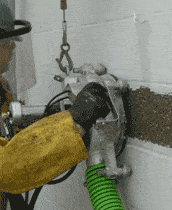
Photo courtesy of Final Coat Painting
Power-tool cleaning
Power-operated hand tools include power sanders, power grinders, and impact tools such as roto-peens and needle guns. Power tools remove coating by wearing it away (sanding/grinding, Photo 11) or by impact to fracture it from the surface (roto-peens/needle guns).
The impact tools are not commonly used on CMU or brick due to the potential for damage to the substrate. The use of power tools is labor intensive, and they will not remove all traces of coating from the porous block surface. They are best used for localized removal of loose coating, or in the case of power sanding, for feathering the edges of intact coating to create a smooth transition between coats or to the bare substrate (Photo 12).
Chemical stripping
Water-based chemical strippers effectively remove multiple layers of old coating without damaging the substrate. The water-based strippers do not contain methylene chloride or caustic materials, and are biodegradable. The strippers are applied to the surface by brush, spray, or roller.

After application, the dwell time prior to removal depends on the coating type, coating thickness, and ambient temperature, but the typical duration is overnight, followed by removal by pressure washing (Photo No. 13). For small areas, removal can be accomplished by scraping, and bucket and sponge. Depending on the number of layers to be removed, a second application may be necessary.
Coating-removal guidelines, in summary

A few industry standards address the preparation of concrete substrates for painting, but the focus is on floors, bare concrete, and poured concrete. In addition, definitive acceptance criteria for determining the adequacy of cleaning are not provided.
As a point of comparison, when preparing steel surfaces, SSPC/NACE specifications explicitly define the acceptance criteria (e.g., Near-White Blast, Commercial Blast, etc.). No such guidance is available for cleaning masonry surfaces, especially CMU and brick. The industry would be well-served if such standards were developed.
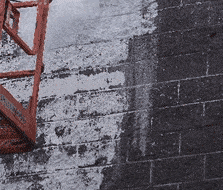
Despite the limitations of the standards in terms of definitive acceptance criteria and the focus on floors and bare and poured concrete, many of the methods are applicable to the removal of existing coatings from CMU and brick. These methods include
- Dry abrasive blast cleaning
- Wet abrasive blast cleaning
- Sodium bicarbonate blast cleaning
- Pressure water cleaning (low pressure <5,000 psi; high pressure 5,000 to 10,000 psi)
- High temperature pressure water cleaning (<5,000 psi)
- Water jetting (high pressure, 10,000 psi to 30,000 psi; ultra-high pressure, >30,000 psi)
- Power tool cleaning
- Chemical stripping
As indicated at the beginning of the article, when formulating a paint-removal project, the review of a few questions will help the facility owner, architect, engineer, and contractor prescreen the various methods of coating removal. These questions are repeated below, together with typical methods of surface preparation that are suitable for each.
Note the methods suggested for each question are based on the author’s experience, rather than an industry standard, and should not be considered as absolute. The attributes of the various methods of surface preparation as reflected by the questions are also summarized in Table 1.
Whenever possible, test areas should be prepared on site to confirm the appropriateness of the method(s) before engaging in wholesale cleaning.
1. Does the existing coating have to be completely removed or just the loose coating?
- a. Methods typically suitable for partial coating removal: sodium bicarbonate blast cleaning, pressure water cleaning <10,000 psi), high-temperature pressure water cleaning (<5,000 psi), water jetting (>10,000 psi), and power-tool cleaning (sanding, grinding).
- b. Methods typically suitable for total coating removal: dry abrasive blast cleaning, wet abrasive blast cleaning, high-temperature pressure water cleaning (<5,000 psi), water jetting (>10,000 psi), and chemical stripping.
2. Can heavy roughening of the block or brick face be tolerated, including some damage to mortar joints?
- a. Methods that will typically result in little to no roughening: sodium bicarbonate blast cleaning, pressure water cleaning <10,000 psi), high-temperature pressure water cleaning (<5,000 psi), water jetting (>10,000 psi depending on pressure and dwell time), power-tool cleaning (sanding, wire brushing), and chemical stripping. Note that for historic preservation, with the exception of chemical stripping, the roughening created by the above methods may be unacceptable.
- b. Methods that will typically result in heavy roughening: dry abrasive blast cleaning, wet abrasive blast cleaning, water jetting (>10,000 psi depending on pressure and dwell time), and power-tool cleaning (impact tools).
3. Can existing paint be allowed to remain within the porosity of the block?
- a. Methods that will typically leave only a slight amount paint in the porous surface: high-temperature pressure water cleaning (<5,000 psi), water jetting (>10,000 psi), and chemical stripping.
- b. Methods that will typically leave more than traces of paint in the porous surface: abrasive blast cleaning, wet abrasive blast cleaning, sodium bicarbonate blast cleaning, pressure water cleaning (<10,000 psi), and power-tool cleaning.
4. Can large volumes of water be tolerated (environmentally, and in terms of potential water intrusion into the block or brick)?
- a. Methods that typically use moderate to no water: dry abrasive blast cleaning, wet abrasive blast cleaning, water jetting (>10,000 psi if vacuum shrouded), power-tool cleaning, and chemical stripping (if removed by scraping and bucket/sponge, rather than pressure washing).
- b. Methods that typically use a large volume of water: sodium bicarbonate blast cleaning, pressure water cleaning <10,000 psi), high-temperature pressure water cleaning (<5,000 psi), water jetting (>10,000 psi without vacuum recovery), and chemical stripping (removed by pressure washing).
5. Can airborne dust be tolerated?
- a. Methods that generate little to no airborne dust: wet abrasive blast cleaning, sodium bicarbonate blast cleaning, pressure water cleaning (<10,000 psi), high-temperature pressure water cleaning <5,000 psi), water jetting (>10,000 psi), power-tool cleaning, and chemical stripping.
- b. Methods that generate a great deal of dust: abrasive blast cleaning.
Table 1
Practical Cleaning Attributes of Surface Preparation Methods1
1—This table represents the practical application of the various methods when used under normal operations based on the author’s experience, but it is not absolute. For example, abrasive blast cleaning can partially remove existing coating from CMU or brick, but it is not commonly used for this purpose.
2—Slight to heavy roughening can occur with water jetting, depending on dwell times and pressures.
3—Roughening created by power-tool cleaning is dependent on the tool being used, ranging from slight roughening with power sanding to heavy roughening with power impact tools.
4—Vacuum shrouding water jetting will significantly reduce the volume of water. Without vacuum shrouding, the volume is greater, but typically not as high as pressure washing at <10,000 psi.
5—A large volume of water is used if the stripper is removed by pressure washing. Much less water is used if removed by scraping and sponge/water, but this is only practical for small localized areas.
 ABOUT THE AUTHOR: Kenneth A. Trimber is the president of KTA-Tator Inc., Pittsburgh. Trimber has over 40 years of experience in the industrial painting field. He holds a bachelor’s degree from Indiana University of Pennsylvania, and is a NACE-Certified Coatings Inspector and SSPC Protective Coatings Specialist. Trimber is a past president of SSPC and a member of the Standards Review Committee, as well as the chairman of the SSPC’s Commercial Coatings Committee, Surface Preparation Committee and Containment Task Group. He is a past chairman of ASTM D1 on Paints and Related Coatings, Materials, and Applications, and authored “The Industrial Lead Paint Removal Handbook.”
ABOUT THE AUTHOR: Kenneth A. Trimber is the president of KTA-Tator Inc., Pittsburgh. Trimber has over 40 years of experience in the industrial painting field. He holds a bachelor’s degree from Indiana University of Pennsylvania, and is a NACE-Certified Coatings Inspector and SSPC Protective Coatings Specialist. Trimber is a past president of SSPC and a member of the Standards Review Committee, as well as the chairman of the SSPC’s Commercial Coatings Committee, Surface Preparation Committee and Containment Task Group. He is a past chairman of ASTM D1 on Paints and Related Coatings, Materials, and Applications, and authored “The Industrial Lead Paint Removal Handbook.”


I like that you talked about an option for total coating removal being dry abrasive blast cleaning. I think that being able to get our garage coating removed, my wife would be a lot happier. We recently moved into our home, and there is a purple and green epoxy on the garage floor, and she has been begging for us to find someone to come do the coating removal. I’ll have to see what I can find, and if the abrasive blast cleaning is an option!
Great knowledgeable article. Very interesting. I used to wonder how they maintain big monuments and building in a proper condition… I’m glad I read this article. Great technologies they are using. Thanks for the informative article.